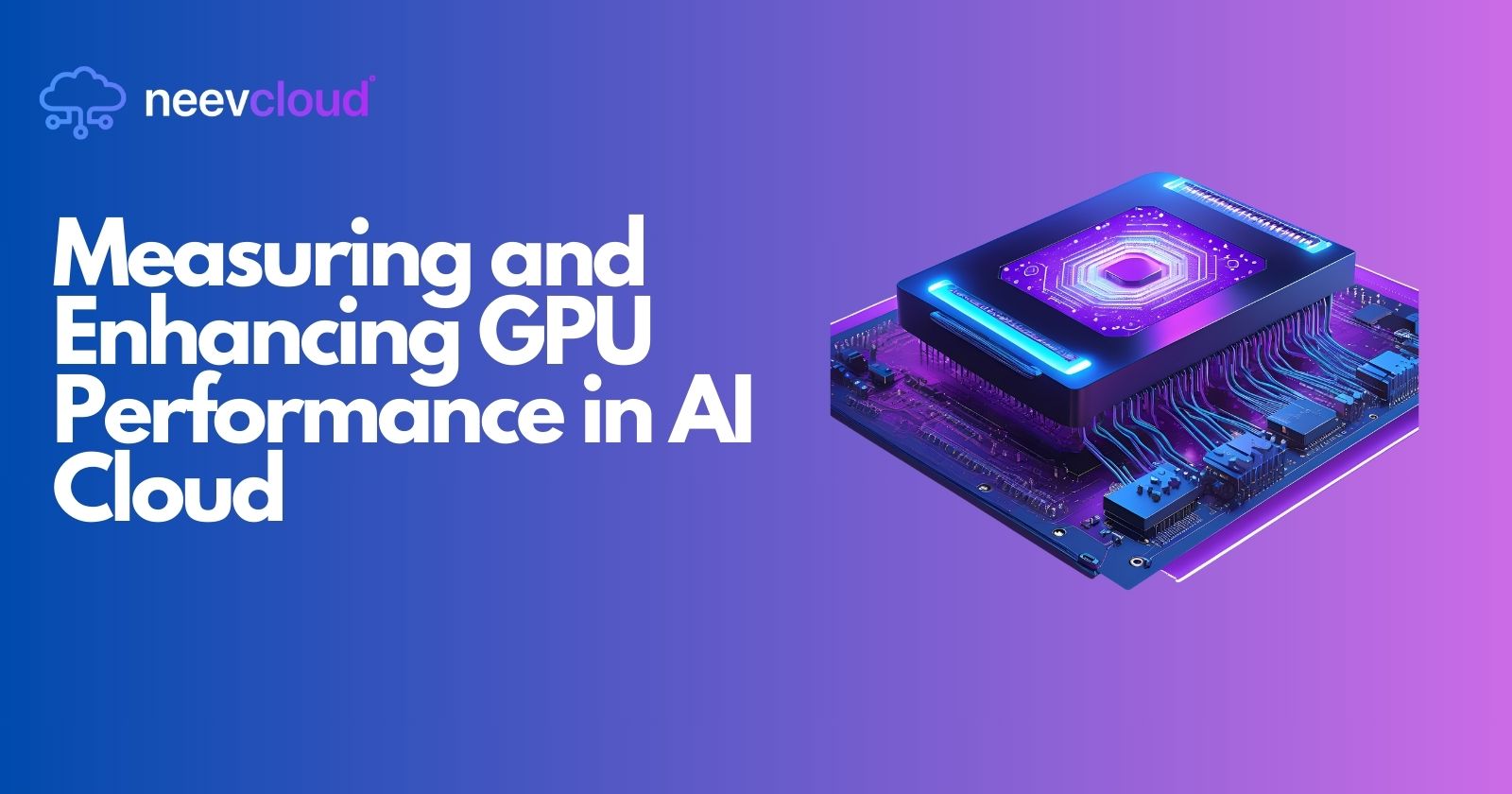Measuring and Enhancing GPU Performance in AI Cloud
 Tanvi Ausare
Tanvi Ausare
In the fast-evolving AI landscape, GPU performance is a critical factor in the successful deployment and scaling of models. As AI workloads scale and demands increase, businesses need powerful GPUs, like NVIDIA's H100 and H200, within their AI Datacenters. However, simply having high-end GPUs is not enough. Organizations must also implement effective strategies to measure and improve performance to ensure that AI models run efficiently and cost-effectively on Cloud GPUs.
This blog post explores how to measure and enhance GPU performance in an AI Cloud environment, offering practical insights and actionable tips.
Understanding GPU Performance in AI Clouds
In an AI Cloud environment, GPUs handle the heavy computational workload of AI tasks, including data processing, model training, and inference. Performance in this context is determined by factors like processing speed, memory bandwidth, and power efficiency, all of which influence the ability to deliver accurate, real-time predictions and insights.
Key Performance Metrics for Cloud GPUs
When evaluating GPU performance in AI Datacenters, there are several crucial metrics to consider:
Throughput: Measures how many tasks a GPU can process over a given period, which is vital for scaling AI applications.
Latency: Critical for applications needing real-time responses, like conversational AI or video analytics.
Utilization Rate: Indicates the percentage of time the GPU is actively processing data, essential for optimizing resource allocation.
Memory Bandwidth: Assesses the speed at which data moves between the GPU and memory, affecting the GPU’s ability to handle large datasets.
Energy Consumption: Important for managing operating costs, especially in extensive AI Datacenters where energy use can become substantial.
Measuring GPU Performance for Optimal Results
To effectively measure GPU performance, teams need the right tools, processes, and understanding of performance benchmarks. Here are some steps to measure GPU performance accurately:
Use Built-in GPU Monitoring Tools
Most modern GPUs, including NVIDIA's H100, come with built-in tools like NVIDIA System Management Interface (nvidia-smi) for monitoring GPU performance metrics, memory usage, and temperature.
DCGM Exporter is another powerful tool that enables metric collection and monitoring across multiple NVIDIA GPUs, allowing real-time tracking of utilization and efficiency.
Benchmarking for AI Datacenter Needs
Benchmarking tools like TensorFlow Benchmark, DeepBench, and MLPerf allow testing of specific AI workloads across different GPUs.
Focus on testing the GPU on real-world applications relevant to your AI Cloud workload, such as image processing, NLP tasks, or deep learning model training.
Integrate Application-Level Profilers
Profiling tools, such as Nsight Compute and Nsight Systems, offer granular insights into how applications utilize GPU resources. These tools can help identify bottlenecks in specific parts of the AI pipeline.
Application-level profilers also allow for micro-optimization, which can reduce processing time and resource consumption.
Implement AI Datacenter Metrics Aggregation
For large-scale AI operations, use metric aggregation platforms like Prometheus and Grafana to monitor performance across multiple GPUs and nodes.
Aggregating metrics in this way allows centralized visibility over GPU usage, identifying trends that might suggest the need for GPU upgrades or workload redistribution.
Run Stress Tests
Conduct stress tests using tools such as CUDA Stress Test to measure how GPUs handle peak loads and extreme conditions, helping gauge their reliability in demanding AI applications.
These tests help establish thresholds for workloads and determine at what point performance declines.
Improving GPU Performance in an AI Cloud Environment
After establishing benchmarks and monitoring, the next step is optimizing performance. Here’s a breakdown of best practices to improve GPU performance in a Cloud GPU setup:
Optimize Data Transfer and I/O Operations
Data movement between CPU and GPU can create bottlenecks, so it’s crucial to minimize data transfer where possible.
Use Unified Memory in CUDA to manage data more efficiently, especially in deep learning models where memory demands are high.
Leverage Mixed Precision Training on Cloud GPUs
Mixed Precision Training is an effective way to accelerate deep learning models on NVIDIA H100 and H200 GPUs, which support FP16 operations. This reduces memory requirements and increases processing speeds.
Implementing automatic mixed precision through frameworks like TensorFlow or PyTorch can lead to a 2-3x speed increase in model training without compromising model accuracy.
Maximize GPU Utilization with Workload Distribution
For multi-GPU setups, efficient workload distribution is essential. Use NCCL (NVIDIA Collective Communication Library) for multi-GPU and multi-node environments, improving communication and parallel processing.
Dynamic workload balancing across GPUs ensures that no single GPU is overwhelmed, leading to consistent performance across all GPUs in the AI Datacenter.
Implement GPU Caching and Pre-fetching Mechanisms
Data pre-fetching can reduce waiting times by loading data into memory in advance, reducing the time GPUs spend idle.
GPU caching, particularly for frequently accessed data, ensures that high-priority data is readily available, thus optimizing performance for real-time AI applications.
Fine-Tune Hyperparameters for GPU-Specific Performance Gains
Hyperparameter tuning can make a significant difference in how efficiently GPUs handle AI tasks. Parameters like batch size, learning rate, and optimizer settings can be adjusted to improve throughput and reduce memory consumption.
Use automated hyperparameter tuning tools (e.g., Optuna or Ray Tune) that can leverage the processing power of Cloud GPUs to explore an optimized range of parameters.
Deploy Edge Nodes with Cloud GPU Offload
For latency-sensitive applications, consider edge nodes with GPU offload capabilities. Edge GPUs can preprocess data before sending it to the Cloud GPU, reducing latency and bandwidth usage.
Offloading some inference tasks to edge devices can free up AI Datacenter resources, allowing better GPU performance for high-priority workloads.
Regularly Update GPU Drivers and CUDA Toolkits
Keeping drivers and toolkits up-to-date ensures compatibility with the latest deep learning frameworks and optimizations, which often include performance enhancements.
Newer driver versions may also include stability improvements, reducing the risk of unexpected slowdowns or crashes in AI Cloud environments.
Advantages of Optimizing GPU Performance in an AI Datacenter
Optimizing GPU performance has significant benefits, especially in environments where AI-driven applications are mission-critical. Here’s how tuning GPU performance can provide a competitive edge:
Cost Savings: Optimized GPUs complete tasks faster, reducing overall compute hours and saving costs in Cloud GPU setups.
Faster Model Training and Inference: Improved throughput and reduced latency mean quicker results, essential for time-sensitive applications like autonomous vehicles or financial modeling.
Enhanced Scalability: Efficient GPUs handle increased workloads without requiring additional resources, making it easier to scale AI applications within budget constraints.
Lower Environmental Impact: More efficient GPUs consume less energy, contributing to a lower carbon footprint, which is increasingly important in modern AI Datacenter operations.
Better User Experience: For applications like Conversational AI, optimized GPU performance enables smoother, real-time responses, improving end-user engagement and satisfaction.
Best Practices for Managing GPU Lifecycle in AI Clouds
Effective GPU lifecycle management is integral to sustaining performance in AI Datacenters. Here are some best practices to keep GPUs in top condition:
Regularly Monitor and Maintain Hardware: Regular maintenance, including cleaning and thermal paste reapplication, can prevent hardware degradation and ensure peak performance.
Plan for GPU Upgrades: As AI models grow, newer GPU versions like the H100 and H200 offer advanced capabilities that support heavier workloads.
Optimize Power and Cooling Solutions: Ensuring proper cooling and power management can reduce wear on GPUs, extending their useful life and sustaining performance.
Adopt a Tiered GPU Deployment Strategy: Consider deploying GPUs based on task priority—dedicate top-tier GPUs for real-time applications while using older or less powerful GPUs for non-time-sensitive tasks.
Leverage Cloud GPU Spot Instances for Cost Savings: Spot instances can provide high-performance GPUs at reduced costs, though they may be less reliable. Use them strategically for non-critical workloads.
Conclusion
For businesses leveraging AI Cloud infrastructures, measuring and improving GPU performance is essential for maximizing the value of cloud investments. By implementing monitoring strategies, using the latest technologies like NVIDIA's H100, and optimizing AI workflows, organizations can achieve higher performance, cost savings, and scalability. Through careful planning and efficient GPU resource allocation, companies can ensure their AI Datacenters remain competitive in a rapidly advancing AI landscape.
Investing in performance improvements not only drives operational efficiency but also creates a foundation for future AI innovation, positioning companies as leaders in their industries. With continued advances in GPU technology and optimized practices, Cloud GPU performance can be harnessed to meet even the most demanding AI challenges.
Subscribe to my newsletter
Read articles from Tanvi Ausare directly inside your inbox. Subscribe to the newsletter, and don't miss out.
Written by
